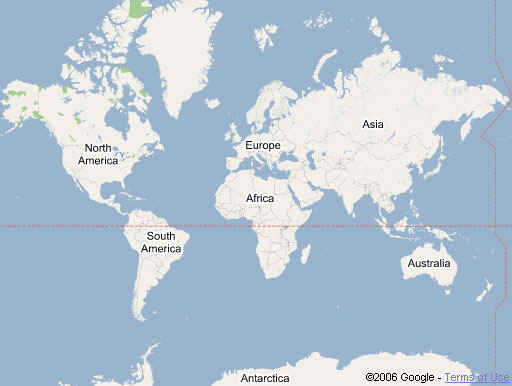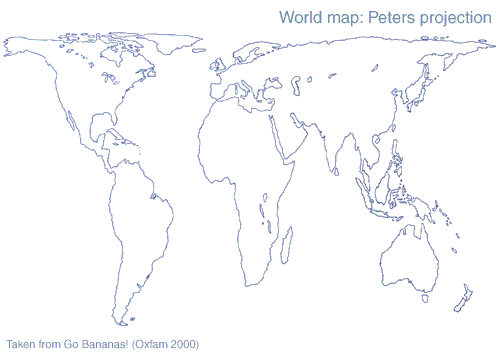There have been a fair number of reports of increased rates of ice melting on the Greenland ice cap – and regardless of why you think temperatures are rising (man made or solar), this sounds like a serious issue. After all, the Greenland ice cap is absolutely massive and unlike the arctic ice which is already part of the ocean mass – when the Greenland ice melts it will add to the sea levels at a catastrophic rate.
Or will they?
Just how big is Greenland? Here is a fairly classic map of the world:

Greenland looks big doesn’t it.
Well, that is not quite the reality – as the map above is a standard Mercator projection – which has the disadvantage of exaggerating the size of landmasses when you move away from the equator (and shrinking them as you get closer to the equator). You might also notice that the equator is not actually half way down the map – but about 55% of the way down, which further exaggerates how the northern continents are enlarged.
Greenland’s actual size in terms of landmass is around 0.8 million sq. miles.
To put that into perspective (pun intended), Africa is around 11.6 million sq. miles – in other words, Africa is 12 times larger than Greenland, but looks smaller than Greenland on the above map.
Here is a rather controversial – if more accurate in terms of landmass size representation of the continents – known as a Peter’s Projection.

Doesn’t Greenland look small now!
So – it could seem to imply that I am suggesting that the melting of the Greenland ice cap is not as catastrophic as it may look like it could be – and from an emotional aspect of looking at the presumed size of the landmass affected, it is indeed less disastrous that it looks.
However, thanks to modern map making – there is a hidden danger at the other end of the world, and that is the Antarctic continent – which is ironically often shown as smaller than it really is due to cropping. Even though the Google map above shows more of Antarctica than is often shown in maps, at first glance most people would probably guess that Greenland and Antarctica are roughly the same size.
Back to the numbers – Africa is around 11.6 million sq. miles, but Antarctica is around 5.3 million sq. miles – that thin strip of land often shown at the bottom of maps is actually huge – and some 6 times larger than Greenland.
So, while the Greenland melt is a problem, it isn’t as big as it looks at first glance. However the Antarctic ice melt could be vastly worse than it looks at first glance of a map.
I guess it goes to show how important it is to be aware of how graphical representations of data can twist how we interpret that information.







Thanks for your essay. I’m always alarmed and appalled at people who talk about the melting of the arctic icecap and rising water levels in the same breath. One other point that’s worth mentioning too. At current rates of melting it will take the Greenland glacier about 25,000 years to disappear. Everyone says, “the ocean’s rising, we’ll all be drowned.” But the ocean has been rising for the last 10,000 or 12,000 years (since the end of the last ice age.) If that hasn’t destroyed civilization yet I don’t know that another foot per century will do it either.
A couple of observations:
Firstly, as the temperature rises – the melting rate will rise significantly, so we do face a situation where sea levels will rise much faster than before.
Secondly, I agree that rising sea levels wont in themselves “wipe of civilisation”, but it will result in trillions of dollars in costs as most of humanity lives next to the sea in fairly low lying land – so whole cities and vital fertile land will become submerged.
Generally, that is not good – and the cost of trying to deal with the issue is a lot less than simply letting it happen.
There is also the impact on wildlife which is less capable of dealing with the changes.
Another thing accelerating the melting and overall warming is the difference in light/heat reflectivity of Ice(white) and Ocean(black). You will start to see more of a exponential increase in melting and warming rates.
The solute in the ocean will be diluted with fresh water shutting down other natural systems such as the “ocean heat conveyer”